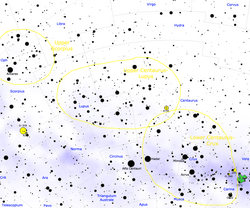Scorpius–Centaurus Association
The Scorpius–Centaurus Association (sometimes called Sco–Cen or Sco OB2) is a group of stars near the Sun. They are 380 to 470 light years away.[1]
They are young stars which all formed from the same cloud of material. They range from 11 to 15 million years old.[2] They include the massive Antares, and most of the stars in the Southern Cross.[3]
The Sco–Cen OB association is the main part of a large complex of recent (<20 million years) and ongoing star-formation. The complex contains several star-forming molecular clouds in Sco–Cen's immediate vicinity.
The stellar members of the Sco–Cen association have nearly parallel velocity vectors, moving at about 20 km/s with respect to the Sun. The variation of velocity within the subgroups is about 1–2 km/s,[4] and the group is most likely no longer held together by gravity. Several supernovae have exploded in Sco–Cen over the past 15 million years, leaving a network of expanding gas superbubbles around the group.[5]
Iron-60 found in fossilised bacteria in sea floor sediments suggests there was a supernova near the solar system about 2,000,000 years ago.[6][7] Iron-60 is also found in sediments from 8 million years ago.[8]
Scorpius–Centaurus Association Media
Main associations of the Solar antapex half of the galactic plane, with Sco-Cen on the left
Close up on the Orion Arm, with major stellar associations (yellow), nebulae (red) and dark nebulae (grey) coreward from the Local Bubble with Sco-Cen.
References
- ↑ de Zeeuw P.T. et al 1999 (1999). "A Hipparcos census of nearby OB Associations". Astronomical Journal. 117 (1): 354–399. arXiv:astro-ph/9809227. Bibcode:1999AJ....117..354D. doi:10.1086/300682. S2CID 16098861.
- ↑ Mark J. Pecaut, Eric E. Mamajek & Eric J. Bubar 2012. A revised age for Upper Scorpius and the star formation history among the F-type Members of the Scorpius-Centaurus OB Association (2012). "A Revised Age for Upper Scorpius and the Star Formation History Among the F-Type Members of the Scorpius-Centaurus Ob Association". Astrophysical Journal. 746 (2): 154. arXiv:1112.1695. Bibcode:2012ApJ...746..154P. doi:10.1088/0004-637X/746/2/154. S2CID 118461108.
- ↑ Preibisch, T. & Mamajek E. 2009 (2008). "The nearest OB Association: Scorpius-Centaurus (Sco OB2)". Handbook of Star-Forming Regions. 2: 0. arXiv:0809.0407. Bibcode:2008hsf2.book..235P.
- ↑ Madsen S. et al 2002 (2002). "Astrometric radial velocities. III. Hipparcos measurements of nearby star clusters and associations". Astronomy & Astrophysics. 381 (2): 446–463. arXiv:astro-ph/0110617. Bibcode:2002A&A...381..446M. doi:10.1051/0004-6361:20011458. S2CID 17596452.
- ↑ de Geus E.J. (1992). "Interaction of stars and interstellar matter in Scorpio Centaurus". Astronomy & Astrophysics. 262: 258–270. Bibcode:1992A&A...262..258D.
- ↑ Belinda Smith (Aug 9, 2016). "Ancient bacteria store signs of supernova smattering". Cosmos.
- ↑ Peter Ludwig; et al. (Aug 16, 2016). "Time-resolved 2-million-year-old supernova activity discovered in Earth's microfossil record". PNAS. 113 (33): 9232–9237. arXiv:1710.09573. Bibcode:2016PNAS..113.9232L. doi:10.1073/pnas.1601040113. PMC 4995991. PMID 27503888.
- ↑ Colin Barras (Oct 14, 2017). "Fires may have given our evolution a kick-start". New Scientist. 236 (3147): 7. Bibcode:2017NewSc.236....7B. doi:10.1016/S0262-4079(17)31997-8.

